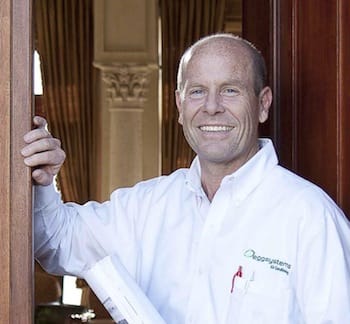Many government jurisdictions have impressive goals set to reduce greenhouse gas emissions significantly. What if the reduction of greenhouse gas emissions from commercial buildings had a correlation to the reduction of Legionella outbreaks?
In New York, the new goal is to be 100% Carbon Neutral by 2040. ConEd has issued a gas moratorium as of March 15th. They will no longer be accepting applications for natural gas connections from new customers in most of their Westchester County service area beginning March 15, 2019
 Interestingly, the new regulations for cooling towers are getting pretty tight. NYC health inspectors are required to test cooling towers every three months. When you add the increased costs to treat, maintain, and inspect cooling towers to the social cost of Legionella outbreaks associated with cooling towers, it might be easier than we think to just label cooling towers as a danger to health and human safety.
Interestingly, the new regulations for cooling towers are getting pretty tight. NYC health inspectors are required to test cooling towers every three months. When you add the increased costs to treat, maintain, and inspect cooling towers to the social cost of Legionella outbreaks associated with cooling towers, it might be easier than we think to just label cooling towers as a danger to health and human safety.
By doing the right thing; coupling buildings with infrastructure and the earth, we not only eliminate greenhouse gas emissions, but we eliminate the possibility of legionnaire’s disease outbreaks from cooling towers.
Just a quick look during a Google search on the day that I’m writing this article reveals several concerns, many of which are related directly to cooling towers in building cooling systems. Here are the top few:
- 1 dead, 1 sickened after Legionnaires’ outbreak at former Best Western Times Union-In New York, including New York City, between 500 and 1,000 cases of legionellosis are diagnosed annually.
- Legionnaires’ disease reports up more than fivefold since 2000; oversight is lacking USA Today – An outbreak in the South Bronx sickened 138 people and killed 16 in 2015. New York has since adopted the nation’s most aggressive measures against the disease: The city required property owners to register cooling towers and get them inspected every 90 days when they are in use.
- City sues ritzy co-op to inspect for Legionnaires’ disease NY Post- City officials don’t know if the co-op’s cooling tower was responsible but say bacteria grows in water systems like the one at the property. An inspection is necessary for “to protect human life and health,” Department of Health Deputy Commissioner Demetre Daskalakis says in the Manhattan Supreme Court suit.

Legionnaires’ disease, a severe form of pneumonia, is caused by the bacterium Legionella found naturally in freshwater environments. It can become a health concern when it breeds and spreads in human-made water systems. Each year in the United States an estimated 10,000 to 18,000 people are infected.
As we get further into this solution, it becomes more obvious to rethink building energy, which needs to be managed anyway. As an example, Stanford University studied their own campus and found that most of the energy expended through combustion could be eliminated when they took advantage of the waste heat coming from the cooling operations for the campus. In fact, the sharing of energy between the buildings on the campus reduced combustion and related emissions, and also reduced the cooling load. This is part of a “thermal energy grid,” and is an illustration of the “Water-Energy Nexus”. The water-energy nexus is the relationship between how much water is used to generate and transmit energy, and how much energy it takes to collect, clean, move, store, and dispose of water.

Speaking of hydronics, geothermal adds unprecedented benefits and possibilities. Moving beyond the scale of single buildings, think of a city blocks, or a “grid” as it’s sometimes referred to. In the winter the residential apartments are going to need heat at the same time as the commercial buildings are rejecting heat (commercial buildings are often nearly 100% cooling dominant due to internal gains). Instead of those commercial buildings rejecting heat to the outdoors through the cooling towers, that heat is now confined in a geothermal pipe-line, easily distributed to the heat-hungry GHPs serving the residential apartments; energy synergy at its best.

Present-day water and energy systems are interdependent. Water is used in all phases of energy production and electricity generation. Energy is required to extract, convey and deliver water of appropriate quality for diverse human uses, and then again to treat wastewater before its return to the environment.
It’s important to understand the different terminologies of water in use in our communities. Potable water is the water deemed safe for drinking. After that, water may be reclaimed and recycled, categorized and described as follows:
- Rainwater (rain caught from the roof or other direct methods of rain capture),
- Storm water (rainwater that has reached the ground or other hard surfaces on the ground such as roads, ovals and paddocks).
- Irrigation and run-off (from sprinkler drainage, overspray and driveways).
- Greywater (from the bath, shower, basin and maybe the kitchen).
- Treated effluent (from a sewage treatment plant).
- Dewatering (for subways and underground infrastructure)
Any of the above fluids piped in the vicinity of a building may potentially be used for heat exchange. Geothermal exchanger-sourced buildings fit the worldwide model of sustainability perfectly. A geothermal building uses less energy than any other HVAC system, whether equipped with central chiller plants or distributed heat pumps. They use renewable energy, pumped to and from the earth, eliminate on-site combustion heating, and eliminate fresh water consumption related to cooling tower operation. With no cooling towers, the normal monthly chemical maintenance, cleanings and health risks are eliminated.
 Jay Egg is a geothermal consultant, writer, and the owner of EggGeothermal. He has co-authored two textbooks on geothermal HVAC systems published by McGraw-Hill Professional. He can be reached at jayegg.geo@gmail.com. The views of this article are strictly those of the author and not necessarily those of Mechanical Hub.
Jay Egg is a geothermal consultant, writer, and the owner of EggGeothermal. He has co-authored two textbooks on geothermal HVAC systems published by McGraw-Hill Professional. He can be reached at jayegg.geo@gmail.com. The views of this article are strictly those of the author and not necessarily those of Mechanical Hub.



